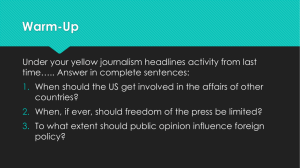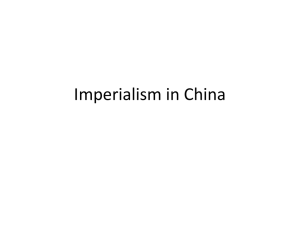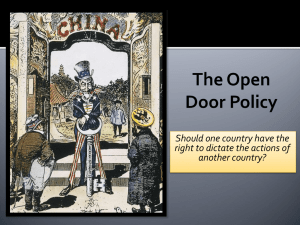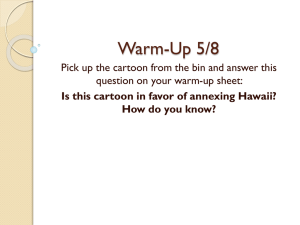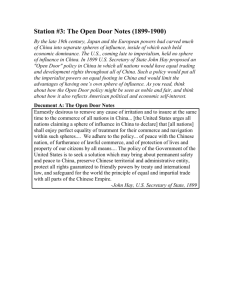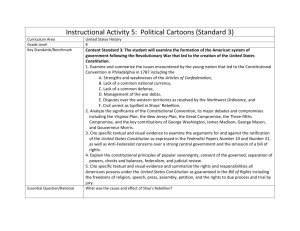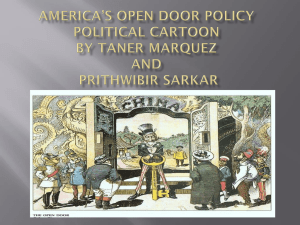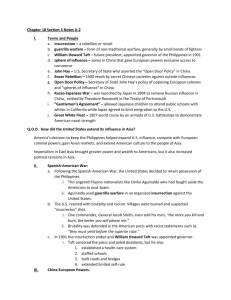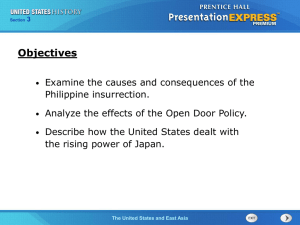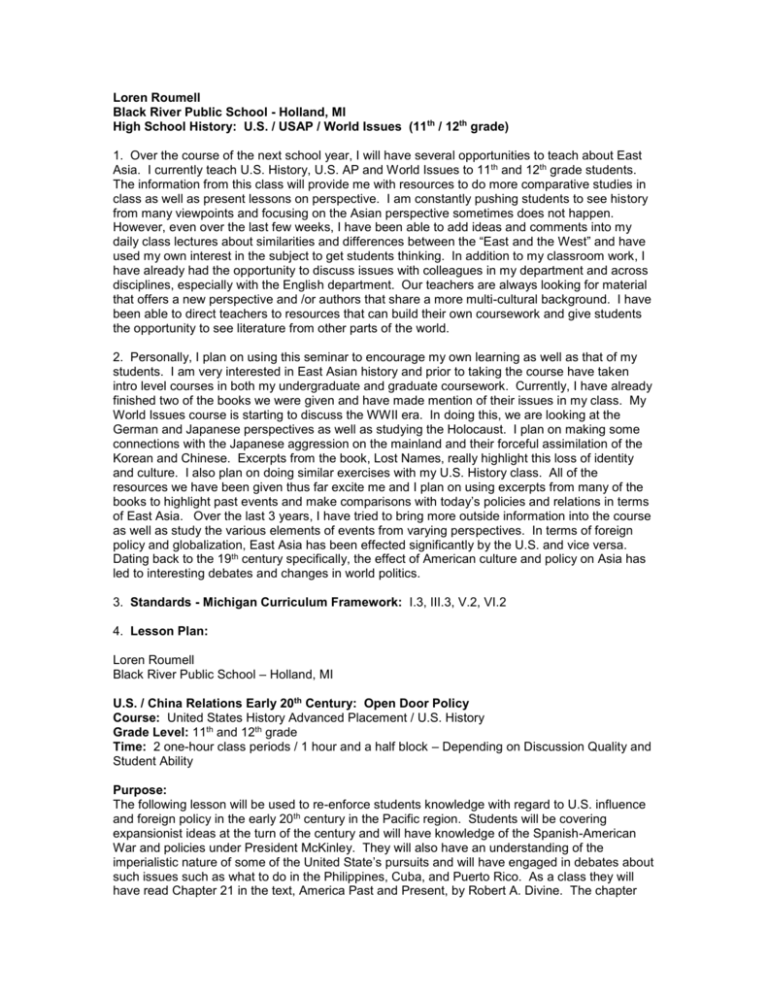
Loren Roumell
Black River Public School - Holland, MI
High School History: U.S. / USAP / World Issues (11th / 12th grade)
1. Over the course of the next school year, I will have several opportunities to teach about East
Asia. I currently teach U.S. History, U.S. AP and World Issues to 11th and 12th grade students.
The information from this class will provide me with resources to do more comparative studies in
class as well as present lessons on perspective. I am constantly pushing students to see history
from many viewpoints and focusing on the Asian perspective sometimes does not happen.
However, even over the last few weeks, I have been able to add ideas and comments into my
daily class lectures about similarities and differences between the “East and the West” and have
used my own interest in the subject to get students thinking. In addition to my classroom work, I
have already had the opportunity to discuss issues with colleagues in my department and across
disciplines, especially with the English department. Our teachers are always looking for material
that offers a new perspective and /or authors that share a more multi-cultural background. I have
been able to direct teachers to resources that can build their own coursework and give students
the opportunity to see literature from other parts of the world.
2. Personally, I plan on using this seminar to encourage my own learning as well as that of my
students. I am very interested in East Asian history and prior to taking the course have taken
intro level courses in both my undergraduate and graduate coursework. Currently, I have already
finished two of the books we were given and have made mention of their issues in my class. My
World Issues course is starting to discuss the WWII era. In doing this, we are looking at the
German and Japanese perspectives as well as studying the Holocaust. I plan on making some
connections with the Japanese aggression on the mainland and their forceful assimilation of the
Korean and Chinese. Excerpts from the book, Lost Names, really highlight this loss of identity
and culture. I also plan on doing similar exercises with my U.S. History class. All of the
resources we have been given thus far excite me and I plan on using excerpts from many of the
books to highlight past events and make comparisons with today’s policies and relations in terms
of East Asia. Over the last 3 years, I have tried to bring more outside information into the course
as well as study the various elements of events from varying perspectives. In terms of foreign
policy and globalization, East Asia has been effected significantly by the U.S. and vice versa.
Dating back to the 19th century specifically, the effect of American culture and policy on Asia has
led to interesting debates and changes in world politics.
3. Standards - Michigan Curriculum Framework: I.3, III.3, V.2, VI.2
4. Lesson Plan:
Loren Roumell
Black River Public School – Holland, MI
U.S. / China Relations Early 20th Century: Open Door Policy
Course: United States History Advanced Placement / U.S. History
Grade Level: 11th and 12th grade
Time: 2 one-hour class periods / 1 hour and a half block – Depending on Discussion Quality and
Student Ability
Purpose:
The following lesson will be used to re-enforce students knowledge with regard to U.S. influence
and foreign policy in the early 20th century in the Pacific region. Students will be covering
expansionist ideas at the turn of the century and will have knowledge of the Spanish-American
War and policies under President McKinley. They will also have an understanding of the
imperialistic nature of some of the United State’s pursuits and will have engaged in debates about
such issues such as what to do in the Philippines, Cuba, and Puerto Rico. As a class they will
have read Chapter 21 in the text, America Past and Present, by Robert A. Divine. The chapter
focuses on the building of American Empires at the turn of the century. The lesson will use
primary sources such as letters, political cartoons, and periodicals to give students a broader
perspective of the era and the issues and concerns with having contacts in East Asia. Students
will participate in-group discussions, complete individual readings and responses, as well as
analyze political cartoons from the era.
Michigan Curriculum Framework:
Standards: I.3, III.3, V.2, VI.2
Questions to Consider / Objectives:
- Why was China valued? Was it purely economic motivations that pushed us into that
region?
- What were the advantages and disadvantages of the Open Door Policy?
- What did the U.S. hope to achieve by proposing such policy? Was it effective?
- Why does the Boxer Rebellion happen? What does this rebellion mean for foreign trade
and policy in the area?
- How effective was the Open Door Policy?
Terms / People:
Spheres of Influence
Open Door Policy
Chinese Nationalist
Boxer Rebellion
President McKinley
John Hay
Imperialism
Materials / Handouts: (Web Sites Listed Below)
Map (Handout) http://ncta.osu.edu/china/swangerK-ch.pdf
Textbook – Divine, Robert A., et al. America Past and Present Revised 7th Edition Advanced
Placement Edition. New York: Pearson Longman, 2005.
Political Cartoons www.kqed.org/w/pacificlink/history/usforeignpol/
www.harpweek.com/09Cartoon/BrowseByDateCartoon.asp?Month=June&Date=9
Open Door Notes – John Hay’s Circular Letter / John Hay’s Letter of Instruction
Video: America 1900. Dir. David Gruben. PBS Home Video 1998
Question Sheets (2): Political Cartoons / Primary Documents / Video (listed below)
Procedure:
We will start the lesson with a brief overview of spheres of influence and the western presence in
China. The second part of the lesson will have students look through documents that highlight
this era in history and come from varying perspectives. In the end, students will be asked to write
a response analyzing the extent to which the Open Door Policy was an effective form of foreign
policy and whether or not it met its purpose. This is a two-part lesson that involves but does not
necessarily need multi-media resources.
Part I: Map Work (15 minutes)
1. Students will be given maps of China at the turn of the century.
2. As a class we will discuss the area and the advantages of being there
3. Spheres of Influence will be discussed and students will be required to identify where each
country was stationed.
Countries: Russia / England / Germany / France / Japan
http://ncta.osu.edu/china/swangerK-ch.pdf
4. Discuss the varying influences and how this might cause a problem for the U.S.
Part II: Political Cartoons / Document Analysis
In order to emphasize the above issues a series of political cartoons and primary source
documents will be distributed to the class. Political Cartoons will be distributed and students must
decide what their perspective is with regard to the Open Door Policy. Students will use the
AAPARTS Rubric provided by the College Board to analyze cartoons. Students will work in
groups discussing and answering questions about the documents for about 20-25 minutes.
When they have finished, the class will discuss the answers students gave on the sheet posted
below.
Cartoon A: Spheres of Influence Cartoon (Textbook p.623)
Cartoon B: Harpers Weekly Cover www.kqed.org/w/pacificlink/history/usforeignpol/
Cartoon C: Boxer Rebellion
http://www.harpweek.com/09Cartoon/BrowseByDateCartoon.asp?Month=June&Date=9
Primary Document 1: Empress Excerpts (Typed below)
http://www.smplanet.com/imperialism/fists.html - Boxer Rebellion Brief Information Article
Primary Document 2: John Hay Circular Letter 1899 (listed below)
Primary Document 3: John Hay Letter of Instruction 1900 (listed below)
(Beginning of Day Two)
Part III: Boxer Rebellion (45 minutes)
Watch the Video and have students answer the questions attached below. The video will need to
be watched in sections. Below are the times to start and stop each section.
1. Begin Tape at 0:00 – 11:32
This first section will correspond with Questions 1-4 below.
2. Start Tape at 24:58 – 28:00
This section will highlight some of the political effects of Chinese policy here in the U.S and leads
into discussion about the International Army.
3. Start Tape at 36:50 – 39:00
Section three discusses the fighting more in-depth and the International Army
4. 42:17 – 47:00
Section Four ends with the death of Eva Price and her family as well as footage from Peking once
the rebellion has been crushed.
For Homework:
Students will read the Boxer Protocol and write a response answering the question below. For
the AP course, the response will be graded according to the AP rubric distributed by the College
Board (www.apcentral.collegeboard.com). Response should be 2-3 pages, typed and doublespaced.
http://web.jjay.cuny.edu/~jobrien/reference/ob26.html - Boxer Protocol
To what extent was the Open Door Policy an effective form of international policy? In what ways
does the Boxer Rebellion re-enforce American ideals about expansion and imperialism at the turn
of the century?
Assessment
Students will be assessed in several ways.
1. Completion of Map Accurately Highlighting Spheres of Influence
a. Students will be required to pay attention to lecture
2. Analytically Interpreting the Primary Source Documents
a. Completion of Question Sheet
b. Answers relate back to the documents and use specific quotes
c. Answers are analytical and don’t simply say what but also why
3. Actively Watching the Video and Completion of Question Sheet
4. Response graded according to the AP College Board Rubric
Resources / Handouts
Web Sites to Consult:
- http://ncta.osu.edu/china/swangerK-ch.pdf - Chinese lesson plan on Imperialism
Maps/Document
- www.nyt.ulib.org - Newspaper Articles from the era / great Resource / hard to print
- www.pinzler.com/ushistory/index.html
- http://odur.let.rug.nl/~usa/D/1876-1900/foreignpolicy/opendr.htm - Open Door Notes
- http://www.smplanet.com/imperialism/fists.html - Boxer Rebellion Brief Information
- www.kqed.org/w/pacificlink/history/usforeignpol/ - Brief Info on Open Door and
Rebellion
- www.harpweek.com - Covers of Harpers Weekly / Great for Images and Political
Cartoons
- www.historyteacher.net - Links to many sites and tons of information
- http://www.historyteacher.net/APEuroCourse/WebLinks/WebLinksNewImperialism.htm#docs - Imperialism Documents
Handouts
Political Cartoon A:
Divine, Robert A., et al. America Past and Present Revised 7th Edition Advanced Placement
Edition. New York: Pearson Longman, 2005. page 623
Political Cartoon B:
Political Cartoon C:
http://www.harpweek.com/09Cartoon/BrowseByDateCartoon.asp?Month=June&Date=9
Primary Document 1: Empress Dowager Tsu His
Taken from www.smplanet.com/imperialism/fists.html
Imperial Message to Chinese Provinces –
“ The present situation is becoming daily more difficult. The various Powers cast upon us looks
of tiger-like voracity, hustling each other to be first to seize our innermost territories… Should the
strong enemies become aggressive and press us to consent to things we can never accept, we
have no alternative but to rely upon the justice of our cause… If our … hundreds of millions of
inhabitants … would prove their loyalty to their emperor and love of their country, what is there to
fear from any invader? Let us not think about making peace”.
Slogan pushed by ministers of the empress taken by the Boxers as their anthem “Support the Ch’ing; destroy the Foreigners”
Primary Document 2: John Hay’s Circular Letter
http://odur.let.rug.nl/~usa/D/1876-1900/foreignpolicy/opendr.htm
First Open Door Note (1899)
Department of State, Washington, September 6, 1899
At the time when the Government of the United States was informed by that of Germany that it
had leased from His Majesty the Emperor of China the port of Kiao-chao and the adjacent
territory in the province of Shantung, assurances were given to the ambassador of the United
States at Berlin by the Imperial German minister for foreign affairs that the rights and privileges
insured by treaties with China to citizens of the United States would not thereby suffer or be in
anywise impaired within the area over which Germany had thus obtained control.
More recently, however, the British Government recognized by a formal agreement with Germany
the exclusive right of the latter country to enjoy in said leased area and the contiguous "sphere of
influence or interest" certain privileges, more especially those relating to railroads and mining
enterprises; but as the exact nature and extent of the rights thus recognized have not been
clearly defined, it is possible that serious conflicts of interest may at any time arise not only
between British and German subjects within said area, but that the interests of our citizens may
also be jeopardized thereby.
Earnestly desirous to remove any cause of irritation and to insure at the same time to the
commerce of all nations in China the undoubted benefits which should accrue from a formal
recognition by the various powers claiming "spheres of interest" that they shall enjoy perfect
equality of treatment for their commerce and navigation within such "spheres," the Government of
the United States would be pleased to see His German Majesty's Government give formal
assurances, and lend its cooperation in securing like assurances from the other interested
powers, that each, within its respective sphere of whatever influence-First. Will in no way interfere with any treaty port or any vested interest within any so-called
"sphere of interest" or leased territory it may have in China.
Second. That the Chinese treaty tariff of the time being shall apply to all merchandise landed or
shipped to all such ports as are within said "sphere of interest" (unless they be "free ports"), no
matter to what nationality it may belong, and that duties so leviable shall be collected by the
Chinese Government.
Third. That it will levy no higher harbor dues on vessels of another nationality frequenting any port
in such "sphere" than shall be levied on vessels of its own nationality, and no higher railroad
charges over lines built, controlled, or operated within its "sphere" on merchandise belonging to
citizens or subjects of other nationalities transported through such "sphere" than shall be levied
on similar merchandise belonging to its own nationals transported over equal distances.
The liberal policy pursued by His Imperial German Majesty in declaring Kiao-chao a free port and
in aiding the Chinese Government in the establishment there of a customhouse are so clearly in
line with the proposition which this Government is anxious to see recognized that it entertains the
strongest hope that Germany will give its acceptance and hearty support. The recent ukase of His
Majesty the Emperor of Russia declaring the port of Ta-lien-wan open during the whole of the
lease under which it is held from China to the merchant ships of all nations, coupled with the
categorical assurances made to this Government by His Imperial Majesty's representative at this
capital at the time and since repeated to me by the present Russian ambassador, seem to insure
the support of the Emperor to the proposed measure. Our ambassador at the Court of St.
Petersburg has in consequence, been instructed to submit it to the Russian Government and to
request their early consideration of it. A copy of my instruction on the subject to Mr. Tower is
herewith inclosed for your confidential information.
The commercial interests of Great Britain and Japan will be so clearly observed by the desired
declaration of intentions, and the views of the Governments of these countries as to the
desirability of the adoption of measures insuring the benefits of equality of treatment of all foreign
trade throughout China are so similar to those entertained by the United States, that their
acceptance of the propositions herein outlined and their cooperation in advocating their adoption
by the other powers can be confidently expected. I enclose herewith copy of the instruction which
I have sent to Mr. Choate on the subject.
In view of the present favorable conditions, you are instructed to submit the above considerations
to His Imperial German Majesty's Minister for L Foreign Affairs, and to request his early
consideration of the subject.
Primary Document 3: John Hay’s Letter of Instruction
Printed from http://ncta.osu.edu/china/swangerK-ch.pdf
APPARTS
Guide to Primary Source Documents
Author:
Place and Time:
Previous Knowledge:
Audience:
Reason to Write:
The Main Idea:
Significance:
Name____________________________
Primary Document Question Sheet
Open Door Policy
Once you have read through the documents, answer the following questions below in complete
sentences. You may discuss answers in your group, but you will complete your own individual
sheet.
1. What is the overall tone of the Empress’s words? How does she view the foreign influences?
In her opinion, what are they doing to China?
2. After reading through John Hay’s Notes, what does he define as the Open Door Policy?
3. What is most important to this policy; ensuring economic growth or maintaining Chinese
culture? Use his words to answer the question.
4. In what ways do the Empress’s words lead one to question the intention of the Open Door
Policy? According to the Chinese, were their best interests at stake?
5. In reviewing the political cartoons, what are some of the conflicts the U.S. has with the policy?
Reference each cartoon.
6. What was the general attitude of the “spheres of influence” when it came to China as
evidenced from Political Cartoon A?
Name _____________________________________
Boxer Rebellion – Movie Questions
While watching the video clips, look to answer the following questions. These questions will be
discussed throughout the class.
1. What is the great irony of the U.S. at the turn of the century with regards to their dealings in
the Pacific?
2. Who was Eva Price? What was her role in China?
3. What are some key characteristics of China from the early 1900s? Look to images you see in
the video and the words from Eva Price and the Chinese.
4. Explain how china was “the bone among many dogs” at the turn of the century.
5. In what ways did the media effect public opinion of the Boxer Rebellion? How was the
Rebellion being portrayed in U.S. papers? Think of headings, words, images again.
6. What precedent does McKinley set in order to quell the Boxer Rebellion? Are McKinley’s
actions constitutional? What justifies his actions?
7. What is the International Army? Should the army have the right to organize and fight in
China?
8. Is revenge on Chinese Boxers justified?
Generic Grading Rubric for Free Response Essays
Adapted from the US AP College Board Standards
8-9
5-7
2-4
0-1
-
Presents a clear well-developed thesis that addresses each aspect of the question.
Supports the thesis with substantial relevant factual information covering the time period.
Understands the complexity of the question.
Provides an effective analysis of the topic.
May contain minor errors that do not detract from the overall essay.
Presents a clear thesis with limited development.
Supports thesis with factual information relevant to the question.
Addresses the complexity of the question in a general way; may lack depth although breadth
will be apparent.
Provides limited analysis.
May contain errors.
Presents an undeveloped thesis.
Lacks supporting information relevant to the question.
Ignores complexity.
Offers little or no analysis.
May contain major errors.
Provides an incompetent or inappropriate response.
May simply restate or paraphrase the question.
Shows little or no understanding of the question.
Essay Grading Scale
Choose how many points the assignment will be worth and match the AP score with an
actual score below.
100 Point
9
=
100
50 Point
9
=
50
8
=
94
8
=
47
7
=
88
7
=
44
6
=
82
6
=
41
5
=
76
5
=
38
4
=
70
4
=
35
3
=
60
3
=
30
2
=
50
2
=
25
1
=
40
1
=
20


